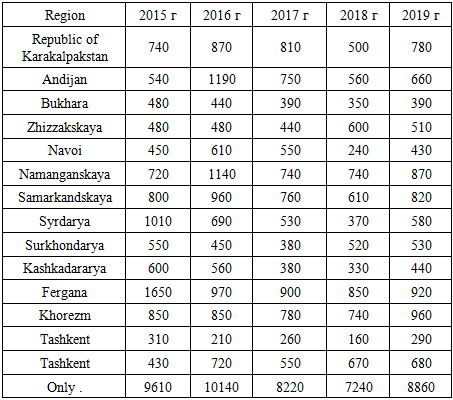-
Paper Information
- Next Paper
- Previous Paper
- Paper Submission
-
Journal Information
- About This Journal
- Editorial Board
- Current Issue
- Archive
- Author Guidelines
- Contact Us
American Journal of Medicine and Medical Sciences
p-ISSN: 2165-901X e-ISSN: 2165-9036
2020; 0(4): 222-225
doi:10.5923/j.ajmms.20201004.11

Eye Injury Pattern Analysis in the Republic of Uzbekistan
Ikramov Otabek Isakovich, Kamilov Holidbek Makhamdzhonovich, Gulyamova Malika Dzhangirovna
Republican Clinical Ophthalmological Hospital Tashkent Advanced Medical Training Institute
Correspondence to: Ikramov Otabek Isakovich, Republican Clinical Ophthalmological Hospital Tashkent Advanced Medical Training Institute.
| Email: |  |
Copyright © 2020 The Author(s). Published by Scientific & Academic Publishing.
This work is licensed under the Creative Commons Attribution International License (CC BY).
http://creativecommons.org/licenses/by/4.0/

The study of eye injury in the Republic of Uzbekistan indicates the need for a differentiated approach to the tactics of patient management and requires the development of algorithms of rehabilitation measures, taking into account the mechanism of trauma, the volume of damage, the terms of circulation and introducing them into the standards of treatment. Analysis of the structure of eye injury in Uzbekistan for the period 2015-2019 revealed a preponderance of domestic injuries (53.4 per cent) among men (65.1 per cent) of the most working age (66.1 per cent) with severe (52.1 per cent) and particularly severe (20.3 per cent) injuries.
Keywords: Eye injury, Republic of Uzbekistan, Dynamics of distribution 2015-2019
Cite this paper: Ikramov Otabek Isakovich, Kamilov Holidbek Makhamdzhonovich, Gulyamova Malika Dzhangirovna, Eye Injury Pattern Analysis in the Republic of Uzbekistan, American Journal of Medicine and Medical Sciences, Vol. 0 No. 4, 2020, pp. 222-225. doi: 10.5923/j.ajmms.20201004.11.
1. Relevance
- Trauma of the visual organ is one of the most socially significant problems of modern ophthalmology due to high prevalence, complexity of treatment, severity of outcomes, high frequency of disability of the victims, among which young, able-bodied people prevail. Nowadays, the visual organ injuries occupy the leading place among the causes of visual impairment and blindness all over the world and continue to be one of the most important medical and social problems, as they most often occur both at home and at work [1,2,3].Traumatic eye damage is one of the causes not only of vision loss, but also loss of the information important organ. Their share is from 2 to 15% of the total number of injuries in the organism. According to Fulcher T.P. and co-author. (2002), there are about 55 million eye injuries worldwide annually, which in 1.6 million patients lead to blindness, mainly due to severe eye damage [5,6,7].Despite significant progress in diagnostics and surgical treatment, the problem of eye injury in Uzbekistan remains unsolved and important not only from a medical but also from a social point of view, as the analysis of specific statistical indicators characterizing their causes is necessary for making optimal decisions regarding treatment tactics. [1,8].Objective of the study: to analyze the structure of eye injury in the Republic of Uzbekistan over a 5-year period depending on the mechanism of injury (2015-2019) [1,8].
2. Materials and Methods
- A retrospective analysis of the structure of eye injury in the Republic of Uzbekistan was conducted for the period 2015-2019. In total 44070 cases of eye injury among adult population were registered. The main documents used to study hospitalized morbidity were excerpts from "Disembarkation cards" (form 236), medical records and registers of inpatients. Statistical methods of research were used - absolute and intensive indicators were studied (per 10000 population). The analytical method has been applied in studying the structure of eye injury and in comparative studies of frequency (intensity) indicators among different groups of the population (age, social, gender and other indicators). All patients underwent standard ophthalmologic examinations; review radiography of orbits in two projections; Comberg-Baltin radiography for localization of fragments; ICCT, MRI.
3. Results and Discussion
- During the analysis of eye injury in the Republic of Uzbekistan for the period 2015-2019 a total of 44070 cases of eye injury among adults were registered (Fig. 1).
 | Figure 1. Eye injury rate in the Republic of Uzbekistan for 2015-2019 (Figure 1) |
|
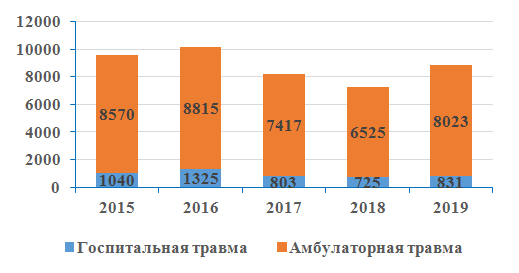 | Figure 2. Ratio of hospital to outpatient injury in the world. (Republic of Uzbekistan for 2015-2019) |
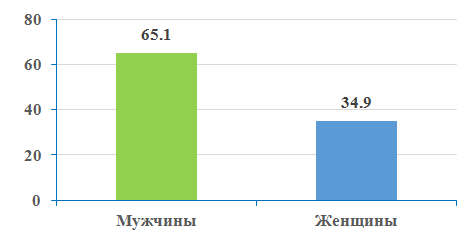 | Figure 3. Dynamics of the gender ratio (in %) in the injury pattern |
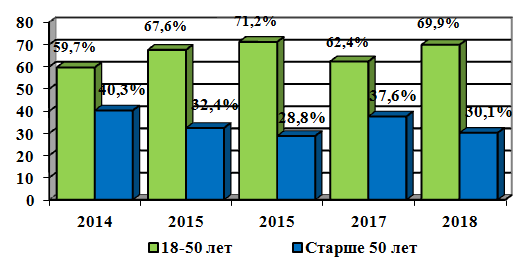 | Figure 4. Dynamics of age ratio (in %) in the structure of visual impairment |
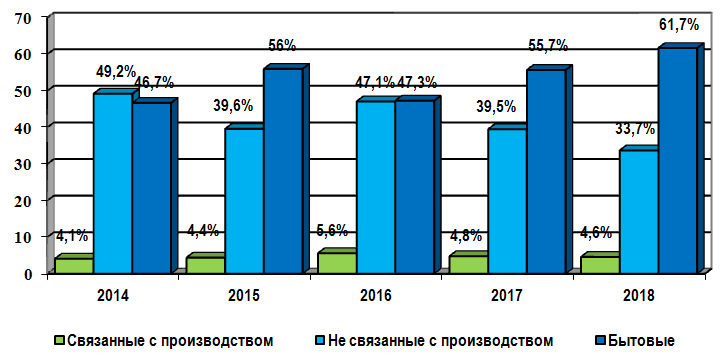 | Figure 5. Dynamics of visual injury distribution (%) eye injury |
|
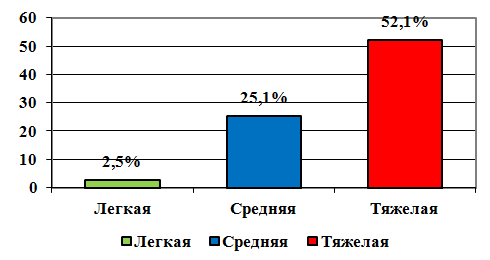 | Figure 6. Distribution of patients by injury severity in the Republic of Uzbekistan for the period of 2015-2019 |
4. Conclusions
- The study of eye injury in the Republic of Uzbekistan indicates the need for a differentiated approach to the tactics of patient management and requires the development of rehabilitation algorithms, taking into account the mechanism of injury, the volume of damage, the duration of circulation and their introduction into treatment standards.Analysis of the structure of eye injury in Uzbekistan for the period 2015-2019 revealed a predominance of domestic injuries (53.4 per cent) among men (65.1 per cent) of the most working age (66.1 per cent), with severe (52.1 per cent) and particularly severe (20.3 per cent) injuries.
References
| [1] | Камилов М.К., Камилов Х.М. Клиника, лечение и профилактика промышленных повреждений органа зрения // Ташкент, 2019.-245 с. |
| [2] | Гундорова Р.А. Современная офтальмотравматология / Р.А. Гундорова, А.В. Степанов, Н.Ф. Курбанова. ― М.: Медицина, 2007. ― С. 28-29. |
| [3] | Волков В. В. Травма глаза (понятие, распространенность, эпидемиология, этиопатогенез, госпитализация, диагностика, классификация) / В. В. Волков, Э. В. Бойко, М. М. Шишкин [и др.] // Офтальмохирургия., 2005. -№ 1. - С. 13-17. |
| [4] | Лебехов П.И. Прободные ранения глаз / П.И. Лебехов.- М.: Медицина, 1974 г.-208 с. |
| [5] | Aaberg Т. Trauma: Principle and technik treatment /Т. Aaberg, P. Sternberg // Retina /Ed. by Ryan. - 2001. -P. 144. |
| [6] | Ashok G. Clinical Diagnosis & Management of Ocular Trauma / G. Ashok [et al] // K. - 2009. - P.300-310. |
| [7] | Banta, J. T. Ocular trauma / J. T. Banta. - 6th ed. - Philadelphia: Elsevier Saunders; 2013. P. 2-25. |
| [8] | Changes in the Incidence of Eye Trauma Hospitalizations in the United States From 2001 Through 2014 / Iftikhar M, Latif A, Farid UZ, et al.//JAMA Ophthalmol. 2019 Jan 1;137(1): P.48-56. |
 Abstract
Abstract Reference
Reference Full-Text PDF
Full-Text PDF Full-text HTML
Full-text HTML